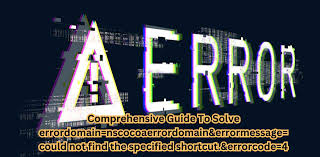When working with macOS or applications developed using Apple’s frameworks, encountering an error such as “Errordomain=NSCocoaErrorDomain&ErrorMessage=Could Not Find the Specified Shortcut.&ErrorCode=4” can be frustrating. This error pertains to the Cocoa framework used predominantly in macOS and iOS development, indicating a problem related to file handling or specific functionalities intended by the software.
What Does Error Code 4 Mean?
Error Code 4 under the NSCocoaErrorDomain usually signifies issues related to file or resource management, specifically when something that the software expects to exist cannot be found. In this case, the “Could Not Find the Specified Shortcut” message suggests that the application was trying to access a shortcut—potentially a file shortcut or a link—that does not exist or has been moved.
Causes of Errordomain=NSCocoaErrorDomain&ErrorMessage=Could Not Find the Specified Shortcut.&ErrorCode=4
The causes with this error could be various, including:
- Misplaced or Deleted Files: The shortcut may point to a file or location that has been moved or deleted.
- Permission Issues: The application may not have the necessary permissions to access the specified shortcut.
- Corrupted Files: The shortcut or the target file might be corrupted, rendering it unreadable.
- Software Bugs: There could be bugs in the application’s code specifically related to shortcut management.

Troubleshooting and Fixing the Error
To resolve this error, follow these steps:
- Verify the Shortcut’s Existence and Location: Ensure that the shortcut exists at the specified location. If it has been moved or deleted, restore it or update the shortcut to point to the correct location.
- Check Permissions: Make sure that the application has the necessary permissions to access the location where the shortcut points. This might involve checking security settings or running the application with elevated privileges.
- Repair Corrupted Files: If the file or shortcut is corrupted, try repairing it using disk utility tools or restore it from a backup.
- Update Software: Ensure that your application and your operating system are up to date. Sometimes, patches or updates include fixes for these types of errors.
- Reinstall the Application: If the problem persists, reinstalling the application can help ensure that all components are correctly configured and that no files are missing or corrupted.
Preventing Future Errors
To avoid this type of error in the future, consider the following tips:
- Regular Backups: Regularly back up your files and shortcuts to prevent loss from corruption or accidental deletion.
- Maintain System Updates: Keeping your operating system and applications up-to-date can prevent many common errors.
- Manage File Locations: Be cautious when moving files that applications depend on, and always update any references or shortcuts to reflect new locations.
Strategies for Handling Error Code 4
For developers and system administrators, error handling strategies might include:
- Logging and Monitoring: Implement logging to track when and where such errors occur to aid in troubleshooting.
- Robust Error Handling in Software: Develop applications with robust error handling that can gracefully manage missing resources without crashing.
- User Education: Educate users about the importance of not moving or deleting critical files and about the use of backups.

FAQ About ErrorDomain=NSCocoaErrorDomain & ErrorMessage=Could Not Find Specified Shortcut & ErrorCode=4
Q: Can this error affect system performance?
A: While the error itself does not directly impact system performance, it can affect the functionality of the application and user productivity.
Q: Is this error exclusive to macOS?
A: Yes, NSCocoaErrorDomain is specific to macOS and iOS, as it is part of Apple’s Cocoa framework.
Q: What should I do if none of the troubleshooting steps work?
A: If the problem continues, contacting Apple Support or the application developer for further assistance is advisable. They can provide more detailed guidance based on the specific context of the error.
